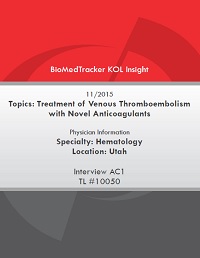Report Library
All Reports
Treatment of VTE - US KOL Interview
November 02, 2015
This interview with a US hematologist focuses on the changing dynamics with the introduction of novel/direct oral anticoagulants (NOAC,
DOAC)
in the treatment of venous thromboembolism (VTE) and prevention of recurrence.
Our interview with a European KOL will follow shortly, with expectations about the 5 major European markets.
Highlights
NOACs vs warfarin
BioMedTracker will be offering KOL Reports and Physician Pulse Surveys for purchase a la carte, or access to all reports and surveys can be purchased as a subscription to KOL Insight. For more information on KOL Insight subscription, please email BioMedTracker or call BioMedTracker Client Services at (858) 200-2357.
For our disclosures, please read the BioMedTracker Research Standards.
Our interview with a European KOL will follow shortly, with expectations about the 5 major European markets.
Highlights
NOACs vs warfarin
- NOACs have gained substantial share among physicians familiar with the data, but up to half of community physicians may still be uncomfortable using them widely, until the availability of reversal agents, and to a lesser extent, better tests to measure the level of drug activity (Note: Praxbind, the antidote for Pradaxa, was approved shortly after the interview).
- Approval of reversal agents should increase use of the NOACs in VTE by 20-30%, and in the long run, they will be used in 60-70% of
cases.
- The antidotes are unlikely to be needed much, but they will act more as reassurance for physicians.
- Some patients will still need to use warfarin due to financial issues.
- Prefers Xarelto, the market leader, because it is once a day, does not have GI side effects, and can be used upfront after the initial diagnosis of DVT.
- Eliquis is his second choice, because it is twice a day and so he is concerned about patients forgetting to take all doses. It is slightly better than Xarelto on bleeding, but the advantage is not enough for him to prefer it. Still, expects that in the overall VTE market, Eliquis will gain further on Xarelto.
- Pradaxa is having difficulties due to several limitations: it is twice daily, a parenteral anticoagulant must be used first, and 1 in 10 patients get
stomach issues.
- Approval of the Pradaxa antidote prior to the factor Xa antidote could give Pradaxa a short-term advantage, perhaps with a small to moderate increase in share.
- Savaysa needs more data published, and there is the issue that it could be underdosed if patients have good renal function (seen in the stroke prevention in atrial fibrillation trial).
- Insurance is a minor hurdle. About half of patients insurances have a preference, and there does not appear to be one that is preferred more than others. On the other hand, there is not much use of prior authorization required to take a NOAC instead of warfarin.
BioMedTracker will be offering KOL Reports and Physician Pulse Surveys for purchase a la carte, or access to all reports and surveys can be purchased as a subscription to KOL Insight. For more information on KOL Insight subscription, please email BioMedTracker or call BioMedTracker Client Services at (858) 200-2357.
For our disclosures, please read the BioMedTracker Research Standards.
| Indications Covered: | Venous Thromboembolism (VTE) |
